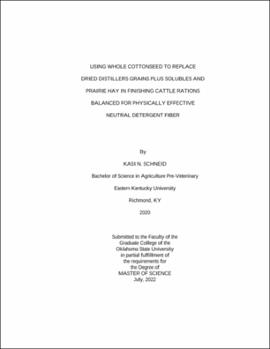| dc.description.abstract | Two experiments were conducted to determine the effects of replacing prairie hay and dried distillers grains plus solubles (DDGS) with whole cottonseed (WCS) in finishing diets balanced for physically effective neutral detergent fiber (peNDF) on animal performance, carcass characteristics, plasma metabolites (glucose, lactate, urea nitrogen, non-esterified fatty acids), and ruminal characteristics. In experiment 1, heifers (n = 103) and steers (n = 104) were blocked by BW within sex and allocated to 1 of 2 experimental treatments using a randomized complete block design (6 pens per treatment) with 17 (n = 10 pens) or 18 (n = 2 pens) animals per pen. Treatments included a control diet (CON; prairie hay, DDGS, dry-rolled corn, and liquid supplement), and a WCS diet (CTN; WCS, dry-rolled corn, and molasses). Both diets contained a vitamin and mineral supplement and urea at the same concentration. Cattle fed the CTN diet tendened to have a greater final BW (P = 0.10), had greater overall ADG, G:F, HCW, fat thickness, and USDA yield grade and had a more neutral fecal pH (P ≤ 0.05) compared to cattle fed the CON diet. The cattle fed the CON diet had a greater final fecal consistency score, plasma urea nitrogen (P ≤ .01), and tended to have a greater plasma lactate concentration (P = 0.06). In experiment two, 4 ruminally cannulated Holstein steers were randomly allocated to the 2 treatment diets from experiment 1. There was a treatment × time interaction for rumen fluid lactate (P = 0.0002) with the cattle fed the CON treatment having a greater concentration at h 2. Rumen fluid pH was affected by time (P = 0.02), but not treatment (P = 0.22). The cattle fed the CON treatment had a greater acetate:propionate ratio, butyrate, and valerate proportions (P ≤ 0.04) and had a tendency for a greater acetate proportions (P = 0.06). The cattle fed the CTN treatment had a greater propionate proportion (P = 0.03). These experiments suggest that WCS can replace the roughage and byproduct protein and fat source within a finishing diet while simultaneously resulting in increased growth and feed efficiency while maintaining an acceptable rumen environment. | |
